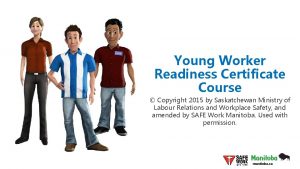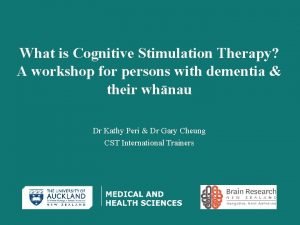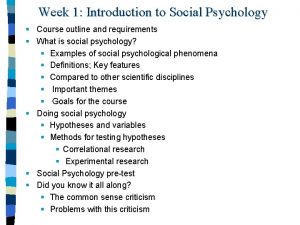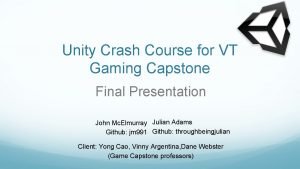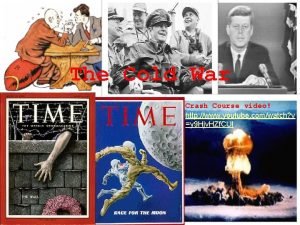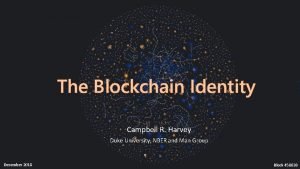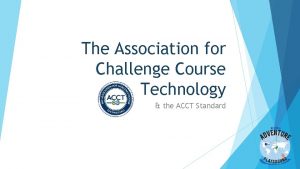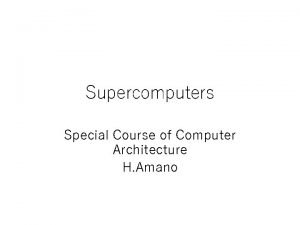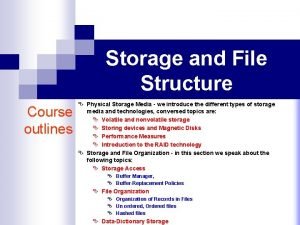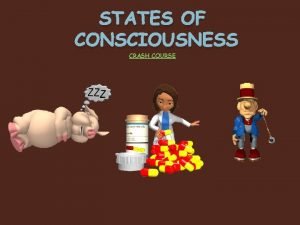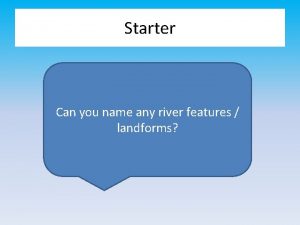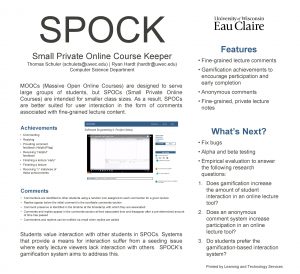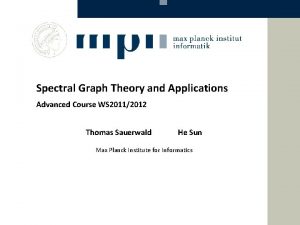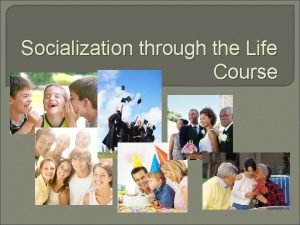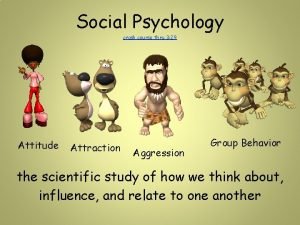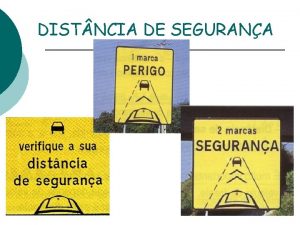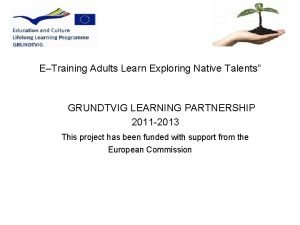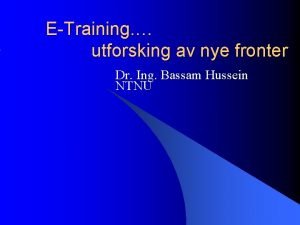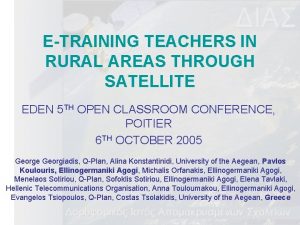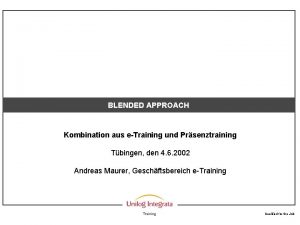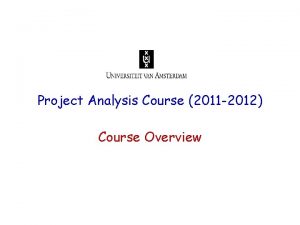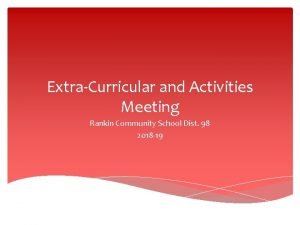DIST PROJECT O 6 A 5 ETRAINING COURSE




































































- Slides: 68

DIST PROJECT O 6 -A 5 E-TRAINING COURSE ADDRESSED TO TRAINERS

INDEX • Unit 1: Introduction • Unit 2: Definition of entrepreneur • Unit 3: Definition of storytelling and applications • Unit 4: Storytelling for training • Unit 5: Digital storytelling

• Unit 1: Introduction A general explanation of DIST project and the training course – Who is addressed – Aim of the course – Moodle platform

Who is addressed? • DIST project: http: //www. distproject. eu/ DIST is a project funded by ERASMUS+ programme, Key Action 2 “Cooperation for Innovation and the Exchange of Good Practices” Action “Strategic Partnership”, which started on September 2015 and will end on August 2018. Objective of the project: DIST project aims to promote the sense of initiative and entrepreneurship (SIE) by increasing entrepreneurial education and training based on the methodology of storytelling. DIST promote the innovative use of the digital storytelling for • spreading sense of initiative and entrepreneurship among unemployed • supporting aspirant entrepreneurs to set up their business • supporting entrepreneurs to improve their performance Entrepreneurship is a competence for everyone, helping people to be more creative and self-confident in whatever they undertake.

Project results Digital storytelling will be used by creating a set of open educational resources. Main Intellectual outputs produced during project: The tools developed within DIST project could be used directly at a distance by the final target groups and mediated by the trainers in face to face training setting.

Target group This project will benefit the following main target groups: • • • lay people, aspirant entrepreneurs and entrepreneurs willing to improve their SIE VET trainers willing to improve their skill in developing the SIE of their learners VET organizations and organizations supporting entrepreneurs and aspirant entrepreneurs: employers’ associations, decision makers involved with entrepreneurship, researchers of the field, etc. This e-training course is addressed to VET trainers

Aim of the course The course is based on the content of the Guide Storytelling for Training and on the videos and will explain how to use the story telling and the videos produced for developing the Sense of Initiative and Entrepreneurship (SIE) to aspirant entrepreneurs and entrepreneurs. The aim of the course is to assure a better exploitation of the Guide

Structure The course is structured in 5 units: – Unit 1: Introduction – Unit 2: Definition of entrepreneur – Unit 3: Definition of storytelling and applications – Unit 4: Storytelling for training – Unit 5: Digital storytelling Each unit includes a PPT explanation of main contents, suggested learning materials and after each unit will be planned an Assessment activity and different suggested activities.

Moodle platform Moodle is a free, online Learning Management system enabling educators to create their own private website filled with dynamic courses that extend learning, any time, anywhere. (www. moodle. org)

• Unit 2: Definition of entrepreneur The entrepreneur, skills and competences – – What does it mean to be an entrepreneur? Skills and competences of an entrepreneur Keys of success and of failure Knowledge and entrepreneur should have

What does it mean to be an entrepreneur? Self-employment means to create your own job through creating a business. Many companies are created with this aim. It lets you became an idea into reality, and is a choice to work for thirds. Advantages Disadvantages Independency Motivation Flexibility Cost effectiveness Be your own boss Risk Responsibility Dedication Investment Link: Land of opportunities https: //www. youtube. com/watch? v=UQ 36 wnp. D 3 Sk&list=PLFFEEAAE 1 F 7 ED 0 A 47&index=3&t=0 s

Definition of entrepreneur An entrepreneur is someone who exercises initiative by organizing a venture to take benefit of an opportunity and, as the decision maker, decides what, how and how much of a good or service will be produced. He supplies risk capital as a risk taker, and monitors and controls the business activities. The entrepreneur is usually a sole proprietor, a partner, or the one who owns the majority of shares in an incorporated venture. What is entrepreneurship spirit? The attitude and process to create a business, combined with the risk, creativity and innovation with a solid management, in a new organization or already exiting one. Is focused to start the change, it contribute to society growth, its productivity, providing technology, products and services. Link: Zero barriers to start up https: //www. youtube. com/watch? v=FJzqd 2 vs. QWQ&list=PLFFEEAAE 1 F 7 ED 0 A 47&index=4&t=0 s

Types of entrepreneurs Vocational For necessity people who has entrepreneurship spirit and the wish to work for themselves, or to create a business. people who has lost their job and consider selfemployment as the only way to work

Engines for business creation To have an entrepreneurship profile To have a business idea Link: Cracking the code https: //www. youtube. com/watch? v=SC 8 Fd. Y 6 j. MBA&index=7&list=PLFFEEAAE 1 F 7 ED 0 A 47

Skills and competences of an entrepreneur The profile of an entrepreneur: we say a person has an entrepreneur profile when he/she has some skills and competences that facilitate to lead new initiatives, in business field, also in others. Many of these skills are linked to personality, but others come from their beliefs, experiences and learnings, so they can be enhanced and improved. The entrepreneur: • Should have new ideas and to achieve to translate them into new business offers • Should be able to take decisions in uncertainty conditions • Should be able to evaluate his own skills and personal aptitudes and complement them with other collaborators, building a team he will lead Link: You only need three things to be an entrepreneur https: //www. youtube. com/watch? v=ao 6 e-b 8 ph. FM

Some characteristics of the entrepreneur profile are: Low risk aversion Humility, sincerity and honesty Trust and selfconfidence Perseverance to achieve goals Energy Entrepreneur Willingness to sacrifice Enthusiasm Independence of criteria Leadership Link: 15 characteristics of an entrepreneur https: //www. youtube. com/watch? v=s. Oje. QV 5 p. Hh 4

Technical management skills Decision making Commercial spirit Training in business management Adaptability Willingness to learn Analysis and synthesis skill Setting goals and the path to achieve them Innovator Knowledge of technics, methods and materials to use Management expertise Intuition and future anticipation Management and organizational skills Business criterion Numerical abstraction skill

Skills that the guide allows to develop Ability to share stories ability to enhance past experience, errors and failures included Ability to use new technologies for one’s own education and for self-promotion ability to plan and define priorities Ability to define and achieve objectives critical attitude and observation positive and constructive emotions management Effective Time Management Self-regulation Ability to focus ability to not postpone Stress Management working memory Problem solving Coping and resilience

Attitudes and skills to reinforce Awareness about the possibility to fail Adaptability and creativity Enhancing past experience Ability development through life experience To reinforce Risk inclination Strong discipline, perseverance and tenacity Passion and confidence Curiosity

Values to promote Vision of the future Openness to the world Innovative intelligence Values Research and creativity Social conscience Culture of change

Keys of success and of failure Keys of success • Some of the key aspects for companies success are: 1. 2. 3. 4. 5. 6. Bet on innovation and development: product or service offered should be the best for customer, so a company can never stop innovation. Update sales’ strategy: Offer incentives, offers, prices, boost internet presence. It is required a deep and interactive analysis of new trends Keep costs at bay: to identify which areas allow to reduce costs and to optimize resources in most efficient way Offer a good service to customers: it is important to maintain and retain customers Teamwork: to promote the collaboration between departments, headquarters, teams… for a common effort to achieve goals. To be update and detect opportunities: to be able to anticipate, to adapt to new demands and to launch new products and services

Key factors of failure Regarding the entrepreneur 1. To start a business with a reason but without motivation 2. Not having entrepreneurial spirit 3. Not being persistent Regarding partners 1. 2. 3. 4. To have not necessary partners To choose partner without relevant criteria Benefits distribution equally when exist unequal investment Lack of trust and communication with partners

Regarding business idea 1. To think success depends on idea 2. To involve in sectors don’t like you or you don’t have knowledge on them 3. To choose activity sectors unattractive Regarding entrepreneur’s family situation 1. To do business depending on family needs and material ambitions 2. To start a business without assuming the impact will have on vital equilibrium Regarding growth management 1. To create business models that don’t provide quick benefits or sustainable ones 2. Be aspirant to entrepreneur and not entrepreneur and do no retire on time Link: Go be an entrepreneur https: //www. youtube. com/watch? v=FOFm 8 f. PP 2 Kc&index=21&list=PLFFEEAAE 1 F 7 ED 0 A 47&t=0 s

Knowledge an entrepreneur should have To start a business To manage a business Link: Take the Leap https: //www. youtube. com/watch? v=qp. EMiqvah. Cw&list=PLFFEEAAE 1 F 7 ED 0 A 47&index=29

To start a business • Market analysis • To elaborate a business plan/ analysis of the business model CANVAS MODEL • Economical and financial plan: to know the necessary initial investment and the business viability • Legal aspects: patents, administrative transactions, legal forms The business idea • • • The business plan Know the market, sector. Business Re entrepreneurship – To buy an existing company Repetition of other success experiences Business opportunity Offer an innovative product Simplicity in starting process

What is a business plan? After having a business idea, it is necessary to start working to make it come true. That means to turn the initial idea into a complete project. In that point , it is necessary to consider all aspects will make the project feasible, from people to allow carry it out (how many, skills, knowledge, responsibilities, dedication…) to the commercial strategy that allows the product or service sale, also the economic, production and organization aspects. For this concretion process, a necessary and useful tool is the BUSINESS PLAN A business plan is…. A working method A helping instrument A set of relevant information A document with a working hypothesis A guide of decision making Link: How to write a business plan https: //www. youtube. com/watch? v=Fqch 5 Or. UPv. A

Funtions of a business plan Internal To check project’s coherence Working instrument Analysis of hypothesis and data jointly External presentation of the project Research of resources

To manage a business Decision making Creativity/ problem solving Setting goals/ planning Communication/ listening/ negotiation Leadership/ team building Monitoring/ diagnosing Learning from experience Time management Stress management Life work balance Link: Follow your dreams. Be an entrepreneur https: //www. youtube. com/watch? v=Cz. JEF 4 DGCWU

• Unit 3: Definition of storytelling and applications What is storytelling: theories, principles, uses and effects – What is storytelling? Fundamental principles – How stories work and which are their effects – Storytelling in cognitive process

What is storytelling? Definition Storytelling cannot simply be defined as the need of sharing stories, but it is a real multi-disciplinary field of study, work and action. Storytelling is a method to influence the target public (whether electorates or customers), to learn and enrich knowledge and skills, it is a tool that allows to effectively share experiences and methods of work, a pathway through which it is possible to define personal and organizational identities, a way of managing the consensus and the power, a way to formulate, check and reformulate political, economic and marketing decisions. Today, storytelling also becomes a device that gives the possibility to manage our own lives with the meanings that characterize them, our own social and professional identity, the global sense of our being in the world.

The National Storytelling Network defines storytelling as: An ancient art form and a valuable form of human expression. Because story is essential to so many art forms, however, the word “storytelling” is often used in many ways. Storytelling is the interactive art of using words and actions to reveal the elements and images of a story while encouraging the listener’s imagination Link: Steve Jobs, example of storytelling https: //www. youtube. com/watch? v=ig. QG 3 DCyddc

What is storytelling? To share: an experience, emotions, feelings, advices A way to: do things, to understand world, to keep control of our life, to construct semantic, to sell something, to educate our kids, to socialize, to explain opinions, to get someone else simulate (experience) something, to alter an event, to get involved. . . Fiction Grandmother Real stories Knowledge of people First teacher Images in a book Is poweful but can also be dangerous A game, a job, a trend, a case history

Benefits of storytelling + Positive psychological effects on people: • Memory and conscious and unconscious learning + Mix of cognitive and emotional process + “Social” effects: • Transmitting cultures, strengthening identities and developing common values, manage the change, construction of direct relationships • Constructive interaction between people • Contribute to the creation and dissemination of new knowledge, to achieve common objectives, to reveal and resolve latent contents + Emotional: + Warm, empathetic, attractive and addictive Link: the magical science of storytelling https: //www. youtube. com/watch? v=Nj-hd. QMa 3 u. A

Characteristics Storytelling is interactive: two-way interaction between a storyteller and one or more listeners the response of the listeners influence the telling of story Use words Use actions: vocalization, physical movement, gesture… Presents a story Encourages the active imagination of the listeners Storytelling listener’s role is to actively create the vivid, multi-sensory images, actions, characters, and events of the story on his or her mind based on the performance by the teller and on the listener’s own past experiences, beliefs and understandings

Principles of storytelling The narrative is therefore an innate construct of the human species, a train of cause and effect, we put things and events in a logical sequence, not only remember what is told also to experience it by simulating in our brain, the value of the story also depends on the audience, connection between storytelling and activations in brain, you should put feelings and emotions on story, everybody has stories to share and every story is unique. ü ü ü ü Innate of humans Cause and effect Put things in logical sequence The value depends on audience Feelings and emotions Everybody has stories to share Every story is unique If you use a story in order to share something the 65 -70% of that message will remain in the memories of the listener (facts only have 5 -10%)

Main objectives of telling a story To entertain To inform To instruct To inspire

How stories work and which are their effects Story is anything told or read that provide a set of events, real of fictitious, an actor and a causal connection between them The stories told, over time, have generated other stories that in turn have oriented identities, objectives, intentions and actions of human beings who have been the protagonists of those stories and who have heard them To tell a good story is necessary : to include images and metaphors, details, emotions, ask questions to the audience, point out differences, change the way to build the story depending on the general purpose, to empower and humanize, to have multiple levels of telling a story, involve the audience…. Andrew Stanton: The clues of a great story https: //www. youtube. com/watch? v=Kx. Dwie. Kpawg

Important elements for a good story Environment Speaker Physical Clear core moral to transfer Create a good environment Catch the attention Eye contact with everybody Clear and good voice level Use energizers Be creative Speech Positive attitude Develop little stories in main story energy Which failures let to success Sometimes make a joke Know the audience and adapt the story Emotional Not be static Find emotional entry points Share your vulnerabilities Use words to help to imagine the situation Be concrete and not too much long Connect stories Listener Project yourself in certain situation Use your imagination to find the solution for the problem

The skills can be developed through stories According to the World Health Organization (WHO) the basic ones are: (page 32) Decision making Problem solving Creative thinking Critical thinking Effective communication skills Interpersonal relationship skills Self-awareness building skills Empathy Coping with emotions Coping with stress

Skills development The stories allow to accumulate behaviors repertoires, decision-making methods, possible reactions to events and solutions to problems. The protagonists of stories make choices, take decisions, with evaluations of different type, with different pathways, with different decision-making methods, using the stories we can acquire plural experiences about choices and decisions, “Training” this our skills. The protagonists of the stories are faced with problems that often they resolve and also the resolution of problems assumes an incredible variety in the different narrative forms that we encounter

Storytelling in cognitive process Ø Stories help us to understand the surrounding reality, they allow us to share our passion and our ideas, allow us to understand the intentions and the reasons that induce us, or other people, to do certain things. Stories are fundamental to understand the reactions of others and to plan our future. Our daily life is full of stories and assumes a narrative dimension whenever we think about them or try to communicate some of their parts. Ø Narration is a cognitive process through which we structure, in temporally significant units, experience units, attributing them order and relations. The same process is repeated when we hear a narration. Ø Our experience, whether direct or indirect enters into the story to complete it and, from the same story, it takes materials in order to build itself, in a relationship of mutual Exchange. Through this Exchange the story assumes meaning, order and . . . the same happens to our experience. Link: How words change the mind https: //www. youtube. com/watch? v=Y 8 wol 2 n. GSp. Y

Tools and uses METAPHOR is something through which we perceive the world and therefore, it is form metaphors that, according to them, the literal and enunciating language derives. It is the understanding of something in the terms of something else.

CORPORATE STORYTELLING Corporate storytelling is the process of using business narrative to make your message memorable. Specifically, the corporate storytelling refers to a universe of values, meanings, symbols that narrate and communicate the Enterprise to its stakeholders. Through stories it is, in fact, possible to transmit emotions and sensations that enrich the information disseminated in enterprises thereby capturing the interlocutor attention widening his/her involvement. How is it used? Storytelling can become a useful instrument to support the business communication, helping to improve the impact, the memorability, credibility, understanding and effectiveness of the transmitted messages both inside and outside the organization Link: What’s the difference between storytelling and corporate storytelling? https: //www. youtube. com/watch? v=v. Iq. Lk 54 MMR 4

• Unit 4: Storytelling for training Benefits, principles and uses of storytelling in training field – Principles of storytelling for training – Uses of storytelling in training

Principles of storytelling for training Principles Activities 1. The socialization promotes the empowerment of the subject Narrative guides short story with connected activities of narrative production, self-analysis and self-exploration. 2. Need to encourage Exemplar stories about specific problems overcome about successful entrepreneurs 3. Promote plural narratives approaches to encourage the recruitment of different points o view Proposal of stories about errors and problems 4. Encourage socialization and comparison To build business narratives with specific narrative techniques or as stories free from particular instructions 5. Necessity to give legitimacy to everybody Use of interrupted stories and construction of the finale 6. Favor the expressiveness Creative writing workshops

Situations in which you can apply storytelling: Education Vocational training Training for trainers Organizations/as sociations that encourage entrepreneurial attitude

Methods to expose the audience the storytelling: Images Painting Graphs Auditory Written narrative Visual

Uses of storytelling in training An education based on principles of storytelling An education centered on the principles of storytelling is a narrative one, which thus includes reading moments and stimulus-narrations, it foresees narrative activities, it can have a narrative framework and it serves as a metaphor for the construction of sense, serves to encourage the multiplication of points of view and thus to know situations better.

Education through storytelling Provides the active involvement in the construction, production and narration of the stories of the target group, it provides for the generation of new metaphors, in other words, it provides for the narrative activation of the students. Narration is not just used but it is also lived, manipulated, co-built. https: //www. youtube. com/watch? v=8 VV 177 IPHKc

• Unit 5: Digital storytelling What is digital storytelling, tools and principles – – Concept of digital storytelling Tools and principles to make a good video The Digital Curricula Story How to analyze and use the videos of the project

Concept of digital storytelling Digital storytelling is the modern expressions of the ancient art of storytelling: Throughout history, storytelling has been used to share knowledge, wisdom, and values. Stories have taken many different forms. Stories have been adapted to each successive medium that has emerged, from the circle of the campfire to the solve screen, and now the computer screen. (Digital Storytelling Association, 2011, paragraph. 1). Link: Digital Storytelling, what is it and what isn’t it? https: //www. youtube. com/watch? v=p. GJyr. Sc. H_hk

Digital storytelling is a natural progression from oral and writing storytelling. Digital storytelling, at its most basic core, is the practice of using computer based tools to tell stories. The idea is to combine the art of telling stories with variety of multimedia, including graphics, audio, video and web publishing. Digital storytelling is an online personal narrative in digital format. Digital storytelling can operate outside institutions or organizations, although may organization such as museums and libraries are using digital storytelling to help to achieve their goals for community engagement. Link: https: //www. youtube. com/watch? v=LVKe. O 5 IIR_A

Tools and principles to make a good video Must be technically well done Duration: taking in consideration that the duration of the human beings’ attention threshold is around 20 minutes Select appropriate contents Page 59 of the Guide

Basic principles of video making for training Technical specifications Do not edit together scenes in which camera is moving Shooting in succession should be realized from different angles Face sequences should be shot by alternating the points of view Change the perspective when you shoot buildings Insert cuts when people are moving Make sure that the passages are harmonious Shots with fast movements could have a longer duration Since wide fields have a more consistent content, their duration must be longer Ø Give Rhythm Ø Start from the wide field Ø Ø Ø Ø

6 ways to communicate messages with a wary editing • • • Editing by analogy Parallel editing Editing by contrast Replacement editing Casual editing Formal editing

Use of graphic representations that • Briefly communicate didactic objectives • Propose questions and doubts at the beginning, during and at the end of the video in order to lead and guide spectators’ reflection • Reveal some crucial moments, in order to stimulate the attention of the student with respect to some guiding issues.

The Digital Curricula Story Definition A Digital Curricula Story is a short personal story about two and a half minutes by combining audio recordings, images, photographic sequences and/or film elements. It tells the story of a person from the perspective of his skills and abilities, motivations, values, passions and professional vocation… The Digital Curricula Story innovates and improves the more commune curriculum vitae because…

Characteristics It uses a different communication style • Telling about the storyteller’s personality, the story is able to involve emotionally the listener It gives an added value to the traditional CV because you can use it to let the recruiter to know you better. You can show your motivations, values, passions and skills through it • It’s a skills self-evaluation tool

A Digital curricula Story is also: • A story created around the professional sphere in digital format • A creative tool to show the key competences • An ex post evaluation device of a training process or a skills assessment • A way to share their personal and professional experience with others • A process of continuous self development

Theoretical and methodological elements Possible applications of Digital Curricula Story: • To communicate strategies in advertising and marketing sector • to disseminate projects and activities, to share experiences, to know stories and job profiles • to develop writing skills, oral expression, technological skills, creativity, display problems, listening skills, as key skills Enterprises School Social Path of guidance and recognition of social skills • as evaluation tool, to give meaning to the paths and implement paths of meaning; also as a self marketing and self empowerment

To make a digital story curricula we implement: Narrative skills To learn how to tell a personal story Relational skills To share and collaborate Digital skills To create video stories Metocognitive skills To co-evaluate the process and the educational path

Learning outcomes for stakeholders • To tell the cultural and professional skills of a person, to think about experience, to activate lifelong guidance routes and self-empowerment • to activate key and transversal competences, guidance and promoting the success , motivation and active participation • to explore the invisible skills of those involved and enhance them within the lifelong learning processes to improve the quality and effectiveness of services For University For facilitators For those involved For the territory and the companies • to find talent in order to cultivate ideas, or opportunities for youth self-employment; to document lives and paths linked to employability

Digital curricula process Sharing Editing Recording Writing/rewriting Briefing and preparation to writing The digital curricula story is formed of approximately 250 words to present in a short film of two or three minutes. It is recommended to include from 15 to 20 photos to illustrate your story

Important element to take into consideration Before starting When you start writing Before recording • Tell about and episode that highlights your personal/ professional skills • Professional achievements • Moments of change that have occurred in your personal/professional life • Critical situations with positive outcomes • Passion, talents, purposes • Motivations, values • Your strong points • Life lesson that had the greatest impact on you • Vision of your future • What you would like to become • You must consider the heart of your story and write the way you speak. • Telling your story you can move from the present, to the past and future • Remember to write a good beginning and a good ending avoiding being dramatic. • Is necessary to read many times the script • Relax and take your time • Speak slowly and clearly • The pictures must be rightfully yours and should have personal connection to you and to your story • A digital story is much better when there is a personal connection to the speaker Link: How to record a video curricula? https: //www. youtube. com/watch? v=PHIy. Xe 4 yh. VY

Some examples of Digital curricula stories • • • https: //www. youtube. com/watch? v=Lsp. Ie. UEl. IFA https: //www. youtube. com/watch? v=k. S 4 pi 76 q. EZw https: //www. youtube. com/watch? v=c_PZTAW 5 pi. Q https: //www. youtube. com/watch? v=3 Sxq-N 2 Brlk https: //www. youtube. com/watch? v=THV 6341 mf. ZA https: //www. youtube. com/watch? v=KK-b 02 BHEx 0

How to analyze and use the videos of the project From different dimensions: Cognitive problem solving, reflexivity, selfevaluation, choice of objectives… Aptitude creativity, resilience, critical curiosity…) Emotional-affectiverelational dimension values, commitment, confidence, selfcontrol… Social interpersonal relationships, cooperation, interdependence…) Development of lifelong dimension times, experiences) Development of life wide dimension formal, non-formal and informal places

The dimensions are not isolated, but their quality depends on inter-relationships. For example: the dimension of problem solving links together the evaluate dimension. The reflective dimension is closely related to the social dimension…. Co-analysis or co-evaluation are the best ways to analyze the use of the videos

Basic principles of video analysis Strategic principles related to: - Trainer - Students for self-evaluation 1. 2. 3. 4. 5. 6. 7. 8. 9. 10. 11. Each video is enriched by watching videos on the same issue; Not all videos are suitable for every kind of target audience (because of language and issue); Analyses may relate to the literal or metaphorical content, the narrative structure, the technical elements and their meaning (close-up, sequence plans…), it is possible to facilitate the analysis of specific images of the most important issues, of agreement/disagreement of the group or of single individuals in training; Analyses may also concern the only emotional feedback of individuals in training with regard to the proposed video; It is important to the identification of the main issue (issues) When you want to focus the attention on particular dimensions of the proposed video you should make them more evident (through lettering, effects, appropriate cuts or execution interruptions); It is essential to allow, during the discussion steps in training sessions, to not to fall into the right/wrong dynamics welcoming with gratitude and respect every opinion and point of view even if you do not agree with the proposed interpretation; Promote the identification of “generative metaphors” in the proposed video; Promote separate interpretations (individual or group) in order to encourage their own socialization and highlight the plurality richness; Favor interpretations that could separate the use of images from the narrative structure (isolate images, read images as independent from the “voices” or from “narrations”) and vice versa; Pay attention to the familiarity and originality of the images/protagonists of the proposed video with regard to the target group favoring the balance between the two dimensions.
 Dist. columnae vertebralis cervicalis
Dist. columnae vertebralis cervicalis Normal probability table
Normal probability table Half brick wall vs one brick wall
Half brick wall vs one brick wall Course title and course number
Course title and course number Chaine parallèle muscle
Chaine parallèle muscle Gstm university of pretoria
Gstm university of pretoria Project management crash course
Project management crash course Bsb51407
Bsb51407 Software project management course
Software project management course The role of project management in achieving project success
The role of project management in achieving project success Project background
Project background Process discriminants in software project management
Process discriminants in software project management Reducing project duration in project management
Reducing project duration in project management Introduction to project management kathy schwalbe
Introduction to project management kathy schwalbe What is strategic assessment in software project management
What is strategic assessment in software project management Importance of software project management
Importance of software project management Perpetual project closure
Perpetual project closure Project indicators enable a software project manager to
Project indicators enable a software project manager to Ms project agile planning
Ms project agile planning Sample methodology for project
Sample methodology for project Varieties of project termination
Varieties of project termination Young worker readiness certificate course
Young worker readiness certificate course Alabama hunter safety courses
Alabama hunter safety courses Cognitive stimulation therapy training course
Cognitive stimulation therapy training course Cem designation
Cem designation Waukee high school course guide
Waukee high school course guide Interlake high school course catalog
Interlake high school course catalog Dpmi delhi
Dpmi delhi Banff pathology course
Banff pathology course Social psychology outline
Social psychology outline Lymph nodes scapula
Lymph nodes scapula Crash course molecular biology
Crash course molecular biology Unity crash course
Unity crash course Stony brook university biology major
Stony brook university biology major Drinking water
Drinking water Module 7 weights and measurements
Module 7 weights and measurements Tractor safety course oregon
Tractor safety course oregon Sqlcourse.com
Sqlcourse.com Ultra thin bonded wearing course
Ultra thin bonded wearing course Upper course of a river
Upper course of a river Upper course of a river
Upper course of a river Holder in due course
Holder in due course Lower course of a river
Lower course of a river Horizontal
Horizontal Value added course brochure
Value added course brochure Gas laws crash course
Gas laws crash course Crash course the crusades
Crash course the crusades Cold war crash course
Cold war crash course Duke university blockchain course
Duke university blockchain course Acct challenge course
Acct challenge course Course applicability system
Course applicability system Basic instructor course tcole
Basic instructor course tcole Basic instructor course texas
Basic instructor course texas Basic instructor course texas
Basic instructor course texas Pepperball instructor course
Pepperball instructor course Special course amano
Special course amano Golf course drainage
Golf course drainage Types of bodys of water
Types of bodys of water File organization course
File organization course Crash course psychology consciousness
Crash course psychology consciousness River cliff and slip off slope diagram
River cliff and slip off slope diagram Adit qualification
Adit qualification Army sponsorship survey
Army sponsorship survey Course keeper
Course keeper Spectral graph theory course
Spectral graph theory course It is a predetermined course of action
It is a predetermined course of action Socialization
Socialization Crash course psychology 29 answers
Crash course psychology 29 answers Epi peri endo
Epi peri endo





















